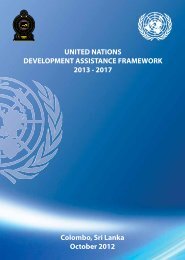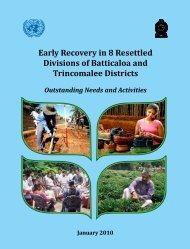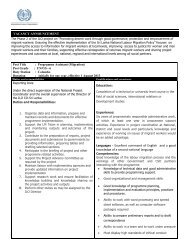Sri Lanka Human Development Report 2012.pdf
Sri Lanka Human Development Report 2012.pdf
Sri Lanka Human Development Report 2012.pdf
You also want an ePaper? Increase the reach of your titles
YUMPU automatically turns print PDFs into web optimized ePapers that Google loves.
of the total deprivations of poor people, based on the DHS<br />
2006/07 dataset, and 53 percent based on the HIES 2009/10<br />
dataset (Table T.5). The difference stems from the fact that the<br />
HDI is a quick summary, while multidimensional poverty is a more<br />
comprehensive assessment based on highly disaggregated data.<br />
Across health indicators, both DHR 2006/07 and HIES<br />
2009/10 underscore how the most deprived groups of society<br />
are affected mainly by poor health: inadequate nutrition, chronic<br />
illness or disability of the head of the household, and infant<br />
and child mortality. DHS2006/07 showed that malnutrition<br />
accounted for 30 percent of multidimensional poverty, while<br />
HIES 2009/10 identified the highest contributor as the chronic<br />
illnesses or disability of the head of the household, at 28 percent.<br />
These issues deserve more attention, including through the<br />
appropriate targeting of social welfare programmes.<br />
The contributions from other indicators to multidimensional<br />
poverty do not show significant variations between the two<br />
datasets. For example, the contributions from the education<br />
dimension based on the two are almost the same: 13 percent<br />
and 12 percent.<br />
Table T.5: Contribution to Multidimensional Poverty, DHS2006/07 and HIES 2009/10<br />
DHS2006/07<br />
HIES2009/10<br />
% contribution % contribution<br />
Dimensions Indicator 10 indicators (2 under to multidimens- 10 indicators (2 under to multidimensnumber<br />
health, 2 under education ional poverty- health, 2 under education ional povertyand<br />
6 under living conditions) DHS2006/07 and 6 under living conditions) HIES2009/10<br />
1. Health 1 At least one member of the 30.0 Calorie (energy) consumption 25.0<br />
household is malnourished<br />
of the household is less than<br />
80 percent of the requirement<br />
andfood<br />
2 One or more children in the 11.0 Head of the household 28.0<br />
household have died<br />
chronically ill or disabled<br />
2. Education 3 No one in household has 9.0 No one in household has 6.0<br />
completed five years of<br />
completed five years of<br />
schooling<br />
schooling<br />
4 At least one school-age child 4.0 At least one school-age child 6.0<br />
not enrolled in school<br />
not enrolled in school<br />
3. Living 5 Household has no electricity 10.0 Household has no electricity 8.0<br />
conditions<br />
6 Household has no access to 5.0 Household has no access 3.0<br />
clean drinking water<br />
to clean drinking water<br />
7 Household has no access to 5.0 Household has no access to 7.0<br />
adequate sanitation<br />
adequate sanitation<br />
8 Household has dirty (mud / 7.0 Household has dirty (mud / 6.0<br />
dung) floor<br />
dung) floor<br />
9 Household uses firewood, 10.0 Household living in a shanty / 8.0<br />
charcoal or dung as cooking<br />
line room<br />
fuel, but does not have a<br />
separate kitchen<br />
10 Household has no car and does 9.0 Household has no car and 8.0<br />
not own more than one radio,<br />
does not own more than one<br />
TV, telephone, bicycle,<br />
radio, TV, telephone, bicycle,<br />
motorcycle or refrigerator<br />
motorcycle or refrigerator<br />
Source: Computations by the report team of the Institute of Policy Studies of <strong>Sri</strong> <strong>Lanka</strong> usingDepartment of Census and<br />
Statistics of <strong>Sri</strong> <strong>Lanka</strong> 2007a and 2010c.<br />
176<br />
sri lanka <strong>Human</strong> <strong>Development</strong> report 2012






